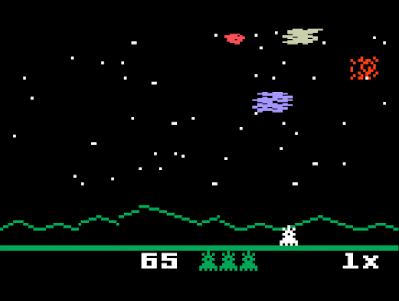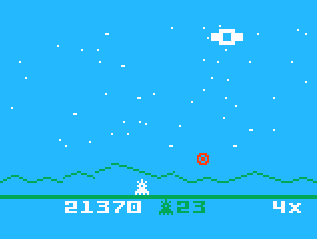Astrosmash: Trailblazing Console Game Design
The Space Invaders formula was dynamite in arcades in the late '70s, and the shoot 'em up genre developed rapidly in the following years, but home consoles were slow to the party. The first official Space Invaders port wasn't released until 1980, but when it was, it immediately doubled sales of the Atari VCS.
The gameplay is very similar to the arcade original, with a few exceptions. The aliens are clearly different, cutting closer to the "little green men" and insectoid aliens of Hollywood than the arcade originals. But Atari changed another thing: they made it easier.
The Art of Challenge
Arcade games are, of course, difficult by design. If developers make them too easy, then it limits how much the game can earn. A famous demonstration of this was when the initial prototype for Galaga was demoed in arcades and didn't earn as much as Namco executives wanted. It wasn't that players didn't like it; rather the demo was easy enough that players were averaging 7 or 8 minutes per game and limiting the profits earned by the machine. That was unacceptable for an arcade machine, and the Galaga we now know and love is more difficult than the original demo.
But the "hard and fast" approach to game design wouldn't make money if it didn't work. Yes, an easy game can lead to a monopolized cabinet, but if arcade gamers really wanted easy games, they wouldn't spend so much money on the hard ones.
Arcade gaming is fueled by adrenaline. With money on the line and, often, an audience looking on, the pressure is on the player to perform. A challenging game makes for higher highs when you succeed and lower lows when you fail, but most importantly it creates drama.
Console gaming is a very different beast. Yes, there will sometimes be an audience watching you play at home, but the atmosphere is very different. Players are less likely to be looking for a quick thrill and more likely to settle in for a gaming session where the challenge grows slowly.
But is it enough for console game designers to just make easier versions of successful arcade games?
Astrosmash
Enter Astrosmash.
Originally intended as a bonus game to accompany a clone of Asteroids, Astrosmash was released as a standalone when its parent game was cancelled. Despite these ignominious beginnings, it ended up being one of the most popular games for the Intellivision console.
Visually, Astrosmash borrows heavily from a smattering of arcade hits, including Asteroids, Space Invaders, and Missile Command. And the player's task is straightforward -- shoot as many things as you can before you run out of lives.
Nothing special, right? Well, not so fast.
What Is a Life Worth, Anyway?
The early-game action is slow going, so take this opportunity to watch your score counter. As you might expect, it goes up when you destroy things, but it also goes down when objects reach the ground. Learning how the various objects contribute to your score will be important in late-game strategy. Here's a table that gives the baseline point value of each object, including points lost when it hits the ground.
As you proceed in the game, the score multiplier will increase, meaning that all objects will be worth (and cost) an amount equivalent to the above numbers times the multiplier*. The highest score multiplier is 6x, at 100,000 points.
Note that your score matters for more than just bragging rights: with every 1000 points you earn, you will gain an extra life. In the early stages, you may find yourself going long stretches without losing any lives, so your stockpile of bonus lives can get quite large. However, the more points you accumulate, the more the speed and destructive power of the falling objects increases. In the later stages, the score multiplier will allow you to accumulate lives more quickly, but the falling objects will kill you more frequently.
The balance between scoring and dying is what differentiates Astrosmash from most arcade games. While it's not unusual for arcade games to award lives at point milestones, it is unusual to make those bonus lives so accessible that death can be a routine part of gameplay. Instead of challenging you to go long stretches without making a mistake, Astrosmash challenges you to use your head to make the most of the time between mistakes.
*A similar system of scoring is used in Missile Command.
Choose Your Target Wisely
Success at Astrosmash ultimately comes down to picking your shots. You won't be able to destroy every falling object, so you want to focus on high-value targets. As a simple example, suppose that you're faced with a small asteroid and a large asteroid, but you only have time to destroy one. Which do you choose?
In the scenario where you shoot the small asteroid and let the big one fall, you gain 20 points from the hit and lose 5 from the object you let fall, giving a net gain of 15 points. On the other hand, if you let the small asteroid fall (-10) and shoot the large one (+10), it's a net change of 0 points. So, you probably want to target the small asteroid.
There's a wrinkle to this calculation, however, because half of the time the large asteroid will break into two smaller ones when hit. In this scenario, your net points will depend on whether you can destroy the resulting small asteroids. If you don't manage to hit either of them, then you're down 20 points from where you started. On the other hand, if you can net a spectacular +40 if you manage to hit both small asteroids that break off from the big one.
In general, I found that it was better to only target large asteroids if they were falling slowly and there were no other high-value targets around. And when you do shoot a large asteroid, fire twice in rapid succession, because your second shot will often destroy any small asteroids that break off from it.
The objects you never want to let fall are the bombs. Anytime they hit the ground, you will lose 100 points (times the multiplier) and a life. Since you need to score 1000 points to make up for that lost life, a fallen bomb effectively costs you 1000 + 100 x multiplier, or 1600 points at the highest stages.
Finally, beware of the smart bombs. They are small, making them hard to hit, and will follow you around the screen. Sometimes it's possible to dodge them, but other times, they will just do this:
The only way to avoid them when they track you horizontally is to use the "hyperspace" button, which will transport you to a random position on the ground.
Buckle Up, It's a Long Ride
Once you get good at Astrosmash, you'll find your playing sessions stretching out for some time. It took me about 45 minutes of playing time to reach the 6x multiplier. From there, you'll encounter further speed increases at 200,000 points, 500,000 points, and 1,000,000 points (I didn't play long enough to reach that last one). Every milestone results in a different speed and object distribution, forcing you to change your strategy. This kind of progressive level design is normally difficult to achieve in fixed shooters without spiking the difficulty, but the low cost of bonus lives in Astrosmash really smooths out the difficulty curve.
The long-play, slow-build design of Astrosmash was unusual in an era when the best-selling console games were just simplified versions of arcade hits. Indeed, second-generation console hardware was barely able to handle the short gameplay of Pac-Man, let alone the kind of extended level design of games like Super Mario Bros or Contra. Astrosmash is clunky by modern standards, so it may not be the best way to spend an afternoon, but it's still a fascinating example of how even the simplest fixed shooter formula can be spread into hours of nonstop gameplay.







Comments
Post a Comment